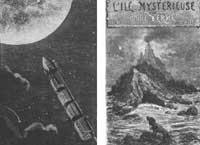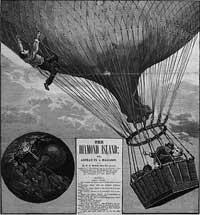Jules Verne, father of science fiction

Verne, from a very young age, expressed his fondness for literature, but his father Pièrre had decided that his eldest son was a lawyer and tried to distance Jules from literature. At the age of 18, he sent his son to Paris to study law. There, the young Verne met Victor Hugo and others, and Father Dumas got the friendship and support of his children. Of course, Verne's literary hobby was accentuated.
When his father asked him to return to Nantes after law studies, he gave him a refusal. Jules began to write theatres and operettas, much of little success and quality, and that work allowed him to devote time to study sciences, since he had already decided that Verne was going to write the literature of the era of science. I wanted to write the science novel and spent time in the chemical library, botany, geology, geography, astronomy, etc. learning. I wanted to merge the fiction and science of writers Sir Walter Scott or Edgar Allan Poe and create a new novel genre.
After several years writing articles and news about science and history, in 1861, ten years after making the decision to write the science novel, Bost aste globoan wrote. For two days he visited 15 editors and they all refused, but finally, the eccentric editor Jules Hetzel gave him his approval. He was then the definitive editor of Hetzel Verne and had a fundamental influence on Verne's literature.
The first novel by Julio Verne, published in 1863, had an absolute success. By then, Verne was 35 years old and was married to Honorine de Vyan. They married in 1857 and four years later their only son Michel Verne was born.
Birth of a gender

Five weeks after the publication of the novel in balloon, the editor and writer signed a 20-year contract. Vern promised to write two novels of the year and thus a new genre was born that would mix adventure, action and science. In tribute to Edgar Allan Poe, Verne titled "Extraordinary Journeys" to his collection, and for more than 40 years the stories of Julio Verne were published in the monthly newsletter Le Magasin d’Éducation et de Récréation: Five Weeks in a Balloon (1863); Journey to the Center of the Earth (1864); From Earth to the Moon (1865); Sons of Captain Grant (1868) and others.
In 1870 he published an underwater journey of 20 miles of leagues, a novel that gave him definitive success, and a mysterious Island, considered as a work at the highest level of Verne. The return to the world was published in 1872 in eighty days and that same year moved to Amiens.
The impressive pace of work put by editor Hetzel greatly affected his health. Throughout his life he suffered paralysis crises that, being diabetic, was deaf and blind. In addition, his favorite nephew, Gaston, shot in the leg and left him lame. Jules Verne died on March 24, 1905 in Amiens.
Verne and science

XIX. In the mid-20th century, the French were fascinated by science, technology and exploration. Scientists and engineers were in fashion, became heroes of the village and Verne knew how to respond to the demand. But according to all biographers, Verne was not so fascinated with the progress of science. In fact, Verne showed in his early writings a critical attitude that made him abandon the publisher Hetzel.
Before and after his death, Verne criticized science and technology, demanding greater responsibility for society, questioning the advantages of science and technology, exalting ecology or criticizing capitalism. Proof of this are Les Cinq cents millions de la Bégum (‘The five hundred million of the Beguma’), L’Île à hélice (‘The island of Helize’), Le Sphinx des glaces (‘Ice Sphinxes’) or L’Inbasion de la mer (‘The Sea Invasion’).
Verne showed the same attitude Paris au XXe Siècle (‘Paris XX. in’) at work (1863). He described Paris in 1960: glass and steel skyscrapers, high-speed trains, motorized combustion cars, computers, fax and global communications network. It was a novel full of technological miracles, but it did not apologize for scientific progress. On the contrary, the novel shows a young idealist who seeks happiness in a world that has become a fully materialistic world.

But Hetzel didn't like his guest's reflections and rejected his work. The novel was published in 1994, after being forgotten in an urn until 1989.
In any case, Verne wrote novels based on scientific reality. He always described the scientific basis of devices or achievements that appeared in novels.
He made science fiction, but according to scientific knowledge and theories, that is, he made real science fiction. Verne's style has since dominated science fiction, but in addition to writers, it has been a source of inspiration for many scientists. It is not strange, therefore, that many of the inventions described by him have come true.
Julio Verne wrote more than 80 books translated into 113 languages.
Buletina
Bidali zure helbide elektronikoa eta jaso asteroko buletina zure sarrera-ontzian










